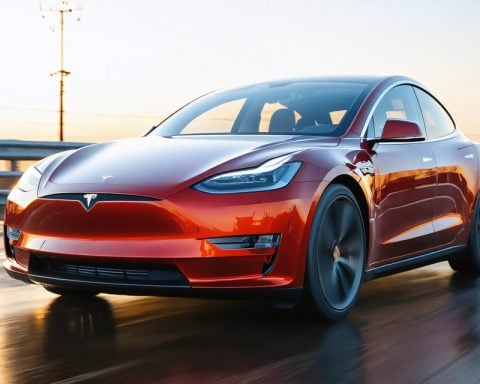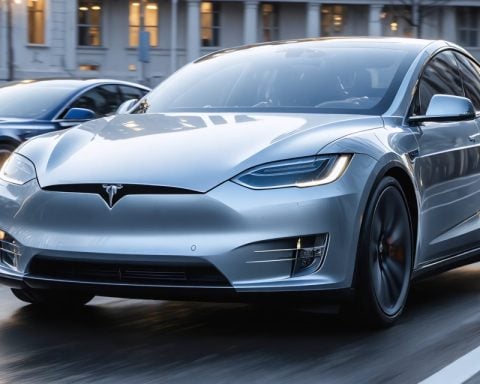- Tesla’s shares sharply declined by nine percent following a 45% drop in European sales, bringing its market cap below $1 trillion.
- Despite strong performance in the U.S., Tesla is struggling in Europe, selling fewer than 10,000 units last month, which hampers its global expansion efforts.
- Elon Musk’s political engagements, including his ties with former President Trump and far-right European leaders, have raised concerns among European politicians and investors.
- Emerging competition from Chinese automakers like BYD is intensifying, particularly in developing self-driving technologies in the electric vehicle market.
- The situation highlights the challenge that success in one market does not ensure global dominance, reflecting Tesla’s unpredictable future path.
Tesla’s whirlwind journey twists and turns through unexpected challenges as the electric vehicle juggernaut hits a speed bump on the global racetrack. Investors felt the shockwaves as Tesla’s shares tumbled a staggering nine percent. This jarring dip followed disheartening news that European sales had hit the skids, plunging 45% from the previous year and forcing the company’s market capitalization below the much-coveted $1 trillion mark.
As Tesla’s sleek vehicles glide across America’s roads, their European counterparts appear stalled at the red light. Fewer than 10,000 units were sold in Europe last month, casting a shadow over the automaker’s ambitious global expansion plans. This faltering performance suggests that while Tesla might be a darling in the American market, its charm hasn’t quite captivated Europe.
Further complicating this automotive drama, Tesla’s charismatic CEO, Elon Musk, has veered into the political fast lane. His controversial advisory role in Trump’s administration and outspoken support for far-right European leaders have caused ripples of discontent among politicians across the continent. What was initially seen as a strategic advantage has now become a point of concern among investors wary of its international implications.
Moreover, competition from Chinese automakers, with BYD leading the charge, introduces another twist to Tesla’s narrative. With both companies racing to deploy advanced self-driving technology, the heat is on in the world’s largest electric vehicle market.
In this global race, Tesla’s path forward remains unpredictable. The electrifying tale of Tesla’s recent market antics underscores a potent reminder: success in one region does not guarantee a smooth ride worldwide.
Electric Shock: Why Tesla’s European Sales Sputtered and What It Means for the EV Industry
How-To Steps & Life Hacks for Competing in the EV Market
1. Localize Production: Establish manufacturing centers within key regions like Europe to reduce logistical challenges and tariffs.
2. Customize Vehicles: Tailor car models to meet regional consumer preferences and regulatory requirements.
3. Boost Charging Infrastructure: Invest in local networks to ease range anxiety, a common barrier to EV adoption.
4. Strategic Partnerships: Work with regional tech companies and suppliers to optimize market entry strategies.
5. Enhanced Customer Engagement: Leverage social media and localized marketing tactics to enhance brand loyalty and consumer perception.
Real-World Use Cases
– Dominant in Urban Markets: Tesla vehicles thrive in dense cities where emissions are heavily regulated and charging infrastructure is more prevalent.
– Rural Adoption Lags: In less populated areas, range anxiety and fewer charging stations pose significant hurdles.
Market Forecasts & Industry Trends
The global electric vehicle market is anticipated to grow at a compound annual growth rate (CAGR) of over 20% through 2030. European sales are expected to rebound, driven by government incentives and stricter emission laws. However, local competitors and Chinese automakers like BYD are rapidly gaining traction, potentially challenging Tesla’s market share.
Reviews & Comparisons
Tesla vs. BYD
– Technology: Tesla leads with cutting-edge Autopilot technology.
– Affordability: BYD offers more budget-friendly models.
– Global Presence: While Tesla has a broader reach, BYD is expanding aggressively outside Asia.
Controversies & Limitations
Elon Musk’s political involvement has led to varying perceptions across different regions. His affiliations could potentially lead to divisive opinions and affect Tesla’s brand image in politically sensitive landscapes.
Features, Specs & Pricing
– Tesla Model 3: Starting price around $40,000 with advanced autopilot features and a range of over 350 miles.
– Tesla Model Y: Slightly pricier at around $48,000 with similar features and enhanced cargo space.
Security & Sustainability
Tesla remains committed to sustainable manufacturing, reducing carbon footprints via gigafactories powered by renewable energy sources. However, concerns around data security, especially with interactive features like Autopilot, call for continuous updates to maintain consumer trust.
Insights & Predictions
Expect Tesla to refocus its European strategy by potentially launching more affordable models to compete with local and Chinese brands. Continued innovation in battery technology and expansion of the supercharger network will remain critical for maintaining leadership.
Tutorials & Compatibility
Tesla offers an intuitive interface and seamless software updates, allowing for ongoing improvements in vehicle performance and user experience. Compatibility with smartphone apps adds convenience and ease of use.
Pros & Cons Overview
Pros
– Cutting-edge technology and autonomous driving capabilities
– Strong brand loyalty and recognition
– Impressive range and performance
Cons
– High initial cost compared to emerging competitors
– Limited charging infrastructure in some areas
– Potential brand impact due to CEO’s public persona
Actionable Recommendations
– For Investors: Stay informed on Tesla’s regional strategies and their adjustment to market dynamics. Consider diversified investments including other EV manufacturers for a balanced portfolio.
– For Consumers: Evaluate Tesla’s cost against its technology benefits and availability of service centers. Assess charging infrastructure in your region prior to purchase.
– For Aspiring EV Makers: Focus on niche markets where Tesla’s penetration is minimal. Leverage unique selling propositions like affordability and localized tech solutions.
For the latest information and updates, visit Tesla.













